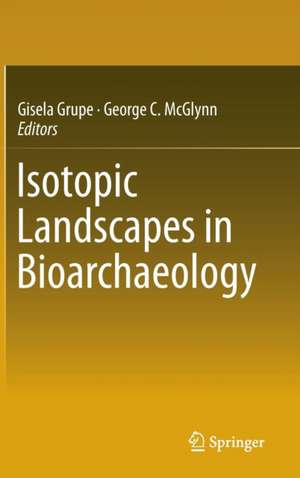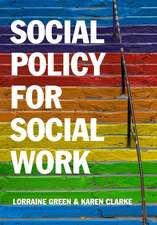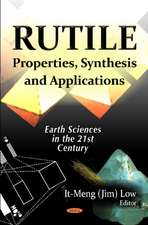Isotopic Landscapes in Bioarchaeology
Editat de Gisela Grupe, George C. McGlynnen Limba Engleză Hardback – 18 mar 2016
| Toate formatele și edițiile | Preț | Express |
|---|---|---|
| Paperback (1) | 724.63 lei 6-8 săpt. | |
| Springer Berlin, Heidelberg – 25 apr 2018 | 724.63 lei 6-8 săpt. | |
| Hardback (1) | 730.65 lei 6-8 săpt. | |
| Springer Berlin, Heidelberg – 18 mar 2016 | 730.65 lei 6-8 săpt. |
Preț: 730.65 lei
Preț vechi: 891.04 lei
-18% Nou
Puncte Express: 1096
Preț estimativ în valută:
139.83€ • 144.45$ • 116.37£
139.83€ • 144.45$ • 116.37£
Carte tipărită la comandă
Livrare economică 26 martie-09 aprilie
Preluare comenzi: 021 569.72.76
Specificații
ISBN-13: 9783662483381
ISBN-10: 3662483386
Pagini: 292
Ilustrații: XII, 238 p. 87 illus., 41 illus. in color.
Dimensiuni: 155 x 235 x 16 mm
Greutate: 0.53 kg
Ediția:1st ed. 2016
Editura: Springer Berlin, Heidelberg
Colecția Springer
Locul publicării:Berlin, Heidelberg, Germany
ISBN-10: 3662483386
Pagini: 292
Ilustrații: XII, 238 p. 87 illus., 41 illus. in color.
Dimensiuni: 155 x 235 x 16 mm
Greutate: 0.53 kg
Ediția:1st ed. 2016
Editura: Springer Berlin, Heidelberg
Colecția Springer
Locul publicării:Berlin, Heidelberg, Germany
Public țintă
ResearchCuprins
Unanswered Questions in the Evolution of Biomineralization.- Complexities of the Ancient Mortuary Rite of Cremation: An Osteoarchaeological Conundrum.- Bones, Rocks, and Flames: Mineralogy and Petrology of Slags and Cremated Bones from Ritual Immolation Sites in Tyrol.- Radiocarbon Dating of Cremated Finds: An Overview.- Mineralogic Characterisation of Archaeological Bone.- Assessing the ‘local’ 87Sr/86Sr Ratio for Humans.- Determination of Geo-dependent Bio-available 87Sr/86Sr Isotopic Ratios for Archaeoelogical Sites from the Inn Valley (Austria) – a Model Calculation.- Provenancing Bronze: Exclusion, Inclusion, Uniqueness, and Occam’s Razor.- Linking Oxygen Isotopes of Animal-bone Phosphate with Altimetry – Results from Archaeological Finds from a Transect in the Alps.- Oxygen and Hydrogen Stable Isotopes in Earth’s Hydrologic Cycle.- Toward an Integrated Isotope Zooarchaeology.- Assigning Elephant Ivory with Stable Isotopes.- Towards Predicting Places of Origin from Isotopic Fingerprints – A case study on the Mobility of People in the Central European Alps.
Textul de pe ultima copertă
This work takes a critical look at the current concept of isotopic landscapes ("isoscapes") in bioarchaeology and its application in future research. It specifically addresses the research potential of cremated finds, a somewhat neglected bioarchaeological substrate, resulting primarily from the inherent osteological challenges and complex mineralogy associated with it. In addition, for the first time data mining methods are applied. The chapters are the outcome of an international workshop sponsored by the German Science Foundation and the Centre of Advanced Studies at the Ludwig-Maximilian-University in Munich. Isotopic landscapes are indispensable tracers for the monitoring of the flow of matter through geo/ecological systems since they comprise existing temporally and spatially defined stable isotopic patterns found in geological and ecological samples. Analyses of stable isotopes of the elements nitrogen, carbon, oxygen, strontium, and lead are routinely utilized in bioarchaeology to reconstruct biodiversity, palaeodiet, palaeoecology, palaeoclimate, migration and trade. The interpretive power of stable isotopic ratios depends not only on firm, testable hypotheses, but most importantly on the cooperative networking of scientists from both natural and social sciences. Application of multi-isotopic tracers generates isotopic patterns with multiple dimensions, which accurately characterize a find, but can only be interpreted by use of modern data mining methods.
Caracteristici
Summarizes the outcome of interdisciplinary workshops based on a network of different sciences such as physical anthropology, archaeology, zooarchaeology, geology, mineralogy, and computer sciences with regard to the research potential in future bioarchaeological research New methods of “fuzzy data mining” by the computer sciences are addressed for the first time Based on the outcomes of international workshops sponsored by the German Science Foundation and the Centre of Advanced Studies at the Ludwig-Maximilian- University Munich









